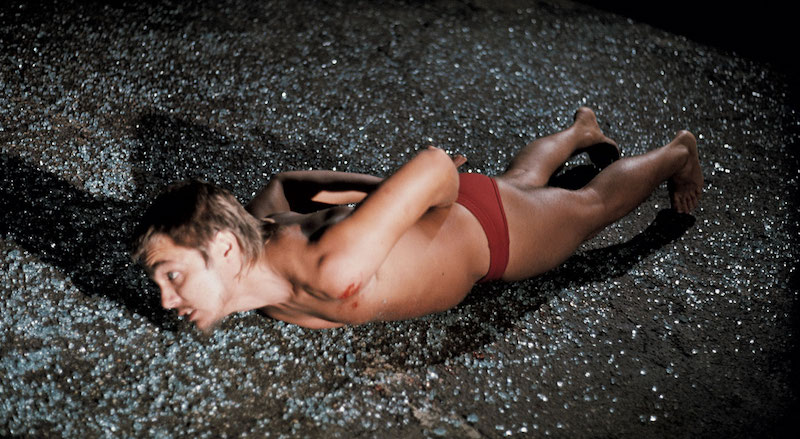
On the new side, Tribeca Film Festival’s embrace of interactive programming – both digital and non-digital – is exciting and trailblazing.
On the digital side, much of VR – especially the kind that is designed for full-body motion (mainly, waving your arms) is still rudimentary, filled with trite Technicolor landscapes and amorphous, lava lamp-like shapes. It’s all very interesting for about 60 seconds.
On the other hand, the VR productions that embrace an immersive documentary experience can convince even the most skeptical Luddites that there’s something in this whole Virtual Reality thing.
For instance, the VR documentary short Kanju (by “project creator” Stephanie Riggs) puts you in the middle of several African landscapes including one densely populated urban community entirely situated on water.
You have a 360-degree view of the Makoko township as you approach a floating school – a nifty solution for the local, education-hungry youth – on a boat.
Similarly, The Artist of Skid Row (project creators Molly Swenson, Tyson Sadler, and Hayley Pappas in association with the nonprofit LAMP) immerses you in an entirely different urban landscape, that of downtown Los Angeles’s gritty homeless district.
You can feel the despair. Yet, hope springs eternal in this ostensible concrete wasteland as the indomitable human spirits shines through a group of homeless artists who call Skid Row their home.
Both projects and a series of others were on show at Tribeca’s Virtual Arcade at The Hub, the festival’s central headquarters just below Canal Street.
Opeyemi Olukemi, Senior Director of Interactive Programs at Tribeca Film Institute, whom we caught up with for an interview right before the festival’s start, seems to agree.
She says: “There’s a new energy when you apply interactivity to a story. It’s an active medium, as opposed to film, which is passive. With VR we see how it immerses many of your senses so that you get a feeling for the story.”
New media offers the opportunities for communities typically left out of mainstream media to get their voices heard.
Opeyemi adds: “We’re talking about all sorts of communities – not just race or class. What does it feel like to be blind in a world populated mostly with people with sight, for example? It allows creators from a wide array of communities to tell their stories in a way not possible before.”
That said, the VR experience in one sense is an isolated one. Essentially, it’s just you, the goggles and the earphones. There could be a terrorist attack happening beside you and with your VR headset on, and you probably wouldn’t notice. So, let’s not pronounce the uniquely communal experience of watching a film with an audience dead quite yet.
The film line-up of this year’s Tribeca was for the most part territory well-traveled by film festivals showcasing indie cinema.
There were the first-time directors, including celebrities like Katie Holmes with her mother-daughter film All We Had, and features whose content will never make it out of the arthouse: case in point King Cobra, based on a true crime story set in the gay porno industry with surprisingly good star turns from Christian Slater and Alicia Silverstone.
However, Tribeca has always been best known for its documentaries, and this year the art documentaries dominate.
Suddenly, filmmakers are turning their cameras on the art world and first and foremost, on singular figures who helped define what we call art today.
If you know nothing more about enfant terrible L.A. artist Chris Burden than he had himself shot with a real bullet as the basis for a performance piece, then Richard Deway and Timothy Marrinan’s film about him, titled simply Burden, is a real treat.
In it, we see Burden as a multi-faceted artist and craftsman, schooled in architecture and as adept in creating highly conceptual art (for his student art degree thesis he locked himself in a school locker) to wonderfully mechanical inventions like his Ode to Santos Dumont, an interpretative tribute to an early dirigible maker and the artist’s last commissioned work. Burden died last year.
The Italian trickster and art bad boy Maurizio Cattelan is artfully profiled in Maurizio Cattelan: Be Right Back by Maura Axelrood.
Think art provocateur. Think master of disguises and sheer shock value. In one of his pieces, the artist lights on fire a baby carriage and kicks it down a public street.
For one of his first gallery shows, he “appropriated” the art from another nearby gallery and presented it as is own. The police were not amused but audiences were delighted.
The film itself becomes an extension of his art. Suffice to say that what you see in the film is not always what you get.
Also blurring the lines between fact and fiction is directors Ian Roderick Gray and Dylan Harvey’s The Banksy Job which catapults the audience from the London art scene to its criminal underground with the charismatic and self-proclaimed “art terrorist” (not to mention former porn star) AK47 acting as a master of ceremonies.
Back here on the other side of the Atlantic, Kristi Zea created a lovingly look back at a seminal contemporary artist and New York art world Seventies scenester in Everybody Knows…Elizabeth Murray.
The 15th edition of Tribeca Film Festival ends today but there are still tickets available.